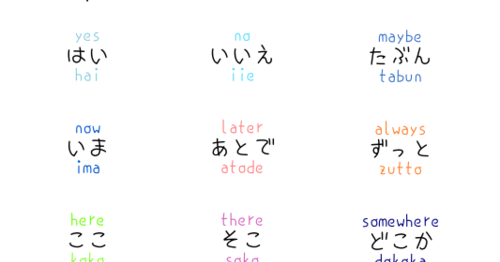
- LEARNING FLUENT JAPANESE FOR BEGINNERS HOW TO
- LEARNING FLUENT JAPANESE FOR BEGINNERS FREE
Read this Complete Guide to Japanese Numbers. Learn Numbers in Kanji (ex: 一、二、三、四 etc…). So for kanji, I will suggest you to start with very basic and useful things. Now you will understand why we are learning kanji, what’s the use of it and why it is so important. After learning above things about kanji, now you can start kanji officially. (Like what is kanji and why should we learn it?) So what to do? Well read below (xD) (I will mention some points which I mentioned above already). Because most likely you will end up hating kanji (Because it’s hard) or might get demotivated. But if you are new to Japanese then don’t directly jump on the kanji from the beginning. Actually If you wanna be so fluent in Japanese then you must know kanji. Well we can’t forget kanji because it's a very important part of Japanese Language.  Look what do we have here? Yes Kanji (again!). Name, hobby, interest, country name, age. And believe me once you start speaking Japanese, you will automatically get the hang of these particles. So to avoid the confusion between は (wa) and が(ga) particles you have to learn in depth about them from YouTube/website or some friends. One of the biggest questions arises to lots of people about particle is: “When to use は (wa) and が(ga) particles?” and I admit that it’s quite confusing if you are new to the Japanese language and you should know when to use which one. You can Google about them or watch some videos on YouTube as well. Important Particles for Beginners: は (wa), が(ga), の(no), を(o).
Look what do we have here? Yes Kanji (again!). Name, hobby, interest, country name, age. And believe me once you start speaking Japanese, you will automatically get the hang of these particles. So to avoid the confusion between は (wa) and が(ga) particles you have to learn in depth about them from YouTube/website or some friends. One of the biggest questions arises to lots of people about particle is: “When to use は (wa) and が(ga) particles?” and I admit that it’s quite confusing if you are new to the Japanese language and you should know when to use which one. You can Google about them or watch some videos on YouTube as well. Important Particles for Beginners: は (wa), が(ga), の(no), を(o). LEARNING FLUENT JAPANESE FOR BEGINNERS FREE
Try to study in depth about these particles (given below) first then you can learn more particles in your free time. But there are some particles which you MUST LEARN to make simple sentences or to get you started with Japanese. Since we are going to learn order wise, I will not recommend remembering all the particles at once because it can be overwhelming and you will get confused. for example: を(wo) read as を(o) and へ (he) read as へ (e). Some hiragana are pronounced differently when they are used as Particles. You might have noticed that I wrote hiragana は (ha) as は (wa). The Japanese language uses around 188 particles. Some but not all can be compared to prepositions in English. They follow other words such as nouns, verbs, and adjectives as parts of a sentence. Particles might be small-the word actually comes from the Latin particula, meaning “little bit” or “part”-but they’re essential parts of Japanese sentences and learning to use them correctly is crucial to acquiring Japanese fluency. Particles in Japanese don’t have any meaning on their own but in sentences, they’re used to bind words together like an infusion of delicious taste. There are so many definitions of “what is a particle in Japanese?” but I will try to make it simple. Using particles you can make a good sentence and understand them in a better way. From here, Japanese really gets exciting. It will help you to understand how they behave and react to certain situations. As of now, I don't have any blogs related to greetings or vocabulary, so you have to google them. Google about common greetings in Japanese. Romaji: Mentioned in Basic Term Blog (above). Kanji: Mentioned in Basic Term Blog (above). LEARNING FLUENT JAPANESE FOR BEGINNERS HOW TO
Katakana Blog: What is Katakana and How to learn Katakana? (With useful resources).Hiragana Blog: What is Hiragana and How to learn Hiragana? (With useful resources).Without vocabularies, you won't be able to understand or speak at all. Remember, Learning Vocabulary is very very important.For now, Mostly focus on Hiragana and Katakana with some vocabulary.No need to learn Kanji as of now, because you are just a beginner (Just try to know a little bit about kanji.

(see the YouTube Video given in Katakana Blog)


While learning Katakana, make sure you are learning vocabulary too. Second Learn Katakana from Katakana Blog (Link is given below).(see the YouTube Video given in Hiragana Blog) While learning Hiragana, make sure you are learning vocabulary too. First Learn Hiragana from Hiragana Blog (Link is given below).Basic Term Blog: What is Hiragana, Katakana, Kanji and Romaji in Japanese Language?.For above terms, you can read this Basic Term Blog:.Once you finish reading the whole whole, start learning with STEP 1 and then STEP 2 STEP 1 NOTE: First read the whole blog(from beginning to end). Why? Because I Am Here! (All might's reference from My Hero Academia anime) Well, Fear not my dear friends, It Is Fine Now. You might want to learn Japanese because of anime, job in Japan, or may be as a part of school/university subject. In this blog, I will explain you that how can you start a Japanese if you are totally new.








 0 kommentar(er)
0 kommentar(er)
